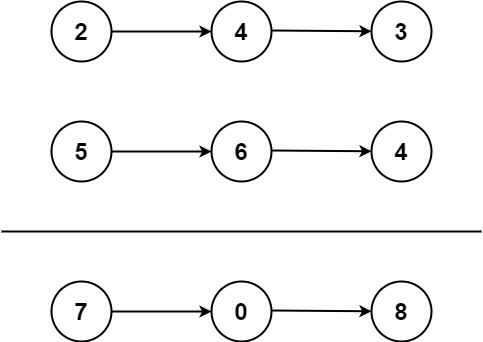LeetCode - Add Two Numbers | Elixir Solution
An Elixir solution for LeetCode's Two Sum problem with detailed explanation and time complexity analysis.

The second problem for LeetCode is called “Add Two Numbers”. As the solutions become more complex, I’m noticing they’re harder to parse visually and am looking for ways to improve how they’re displayed.
For now, let’s squint together at some code and take our time reading through the details ;)
Add Two Numbers - Problem
You are given two non-empty linked lists representing two non-negative integers. The digits are stored in reverse order, and each of their nodes contains a single digit.
Add the two numbers and return the sum as a linked list.
You may assume the two numbers do not contain any leading zero, except the number 0 itself.
Example 1
Input: l1 = [2,4,3], l2 = [5,6,4]
Output: [7,0,8]
Explanation: 342 + 465 = 807
Example 2
Input: l1 = [0], l2 = [0]
Output: [0]Example 3
Input: l1 = [9,9,9,9,9,9,9], l2 = [9,9,9,9]
Output: [8,9,9,9,0,0,0,1]Constraints:
- The number of nodes in each linked list is in the range
[1, 100]. 0 <= Node.val <= 9- It is guaranteed that the list represents a number that does not have leading zeros.
Solution
add_two_numbers/2 expects linked list struct ListNode or nil as arguments and return value.
Here is the ListNode struct:
defmodule ListNode do
@type t :: %__MODULE__{
val: integer,
next: ListNode.t() | nil
}
defstruct val: 0, next: nil
endEach node has a value and a link to the next node.
defmodule Solution do
def add_two_numbers(l1, l2) do
total = 0
exponent = 1
value1 = list_to_integer(l1, total, exponent)
value2 = list_to_integer(l2, total, exponent)
(value1 + value2)
|> Integer.digits()
|> Enum.reverse()
|> to_linked_list()
end
defp list_to_integer(nil, total, _), do: total
defp list_to_integer(node, total, exponent) do
%ListNode{val: current_value, next: next_node} = node
new_total = total + current_value * exponent
new_exponent = exponent * 10
list_to_integer(next_node, new_total, new_exponent)
end
defp to_linked_list([]), do: nil
defp to_linked_list([h | tail]) do
%ListNode{val: h, next: to_linked_list(tail)}
end
endTLDR;
The incoming linked lists are the individual digits of a larger number and they are already reversed. We can iterate over each list, accumulate the total value and increase the power of 10.
Then split the resulting total using Integer.digits/1, reverse the order and rebuild the values into a Linked List.
Time Complexity: O(max(m,n))
Source: https://github.com/tmartin8080/leet
Approach - Explanation
To begin, the data structure we’re working with is a Linked List. Essentially, a Linked List is a list of nodes that each know the location in memory of the next node:
[2, 4, 5]
# becomes:
%ListNode{
val: 2
next: %ListNode{
val: 4,
next: %ListNode{
val: 3,
next: nil
}
}
}(I’ll some more detailed writing on Data Structures soon, but let’s continue for now.)
Given our values are represented as a reversed, linked-list we’d want to first convert the linked lists to an integer value:
[2, 4, 5] -> 542Linked List to Integer
To accomplish this, we set initial values for total and exponent and pass them into a recursive function that is invoked for both linked lists:
total = 0
exponent = 1
value1 = list_to_integer(l1, total, exponent)
value2 = list_to_integer(l2, total, exponent)For the recursive function, we identify the base case:
When the current node’s value is nil we’ve reached the end of the Linked Listdefp list_to_integer(nil, total, _), do: totalTo handle all other cases:
defp list_to_integer(node, total, exponent) do
%ListNode{val: current_value, next: next_node} = node
new_total = total + current_value * exponent
new_exponent = exponent * 10
list_to_integer(next_node, new_total, new_exponent)
endLet’s walk through this function using [2, 4, 5] as an example:
First Iteration:
# total = 0, exponent = 1
%ListNode{val: 2, next: %ListNode{val: 4, ...}} = node
new_total = 0 + 2 * 1 (2)
new_exponent = 1 * 10 (10)The function then calls itself with updated values:
list_to_integer(%ListNode{val: 4, ...}, 2, 10)Second Iteration
# total = 2, exponent = 10
%ListNode{val: 4, next: %ListNode{val: 5, ...}} = node
new_total = 2 + 4 * 10 = 42
new_exponent = 10 * 10 = 100Again calling itself with updated values:
list_to_integer(%ListNode{val: 5, ...}, 42, 100)Third Iteration
# total = 42, exponent = 100
%ListNode{val: 5, next: nil} = node
new_total = 42 + 5 * 100 = 542
new_exponent = 100 * 10 = 1000Again, the function calls itself with updated values:
Notice: the next value is nil
list_to_integer(nil, 542, 100)This will be handled by the base case function head:
defp list_to_integer(nil, 542, _), do: 542Which simple drops our exponent temp variable and returns the value as an integer.
Sum Integers
After converting both linked lists to integers, we can sum them:
(value1 + value2)Because our problem requires a reversed Linked List that represents an integer value, we need to convert the sum value to a Linked List.
Integer to Linked List
First, we convert the integer to an Elixir list and reverse it:
> Integer.digits(542)
[5, 4, 2]
> List.reverse([5, 4, 2])
[2, 4, 5]Then call another recursive function that builds the ListNode struct. Our base case would be:
When the list is empty there are no more nodes to link
defp to_linked_list([]), do: nilOtherwise, separate the head of the list from the tail and build the current node:
# h = 2, tail = [4, 5]
defp to_linked_list([h | tail]) do
%ListNode{val: h, next: to_linked_list(tail)}
endThis function calls itself to build the next node using the tail values.
Complexity Analysis
Given that we have two lists as arguments we can assign their respective sizes to M and N.
We’ll also assign the size of the returned sum integer: X
- Converting both Linked Lists to integers: (
2 steps * M)+ (2 steps * N) - Sum of Integers:
1 step - Split integer:
1 step - Reverse integer:
X steps - Convert integer to Linked List:
X steps
Approx Steps:
M | N | X | steps
-----------------------
1 | 1 | 1 | 8
10 | 10 | ~10 | ~70
100 | 100 | ~100 | ~700X is dependant on the max of M or N
As M or N increase, total steps increase linearly depending on the max of either size.
By dropping constants and taking the worse-case scenario, we can say this algorithm is:
O(max(M, N))
Wrapping up
I’m currently working through different resources on Big O Notation and how to analyze Elixir data structures and algorithms. This is obviously a broad subject so if you find any issues with the ideas or have ways to improve them, feel free to contact me.
Hope you enjoyed this article.
If you have comments or feedback, feel free to hit me up on Twitter: https://twitter.com/tmartin8080
Happy coding!
-- Troy